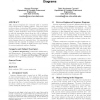57 search results - page 5 / 12 » Reverse Engineering Self-Modifying Code: Unpacker Extraction |
WSE
2003
IEEE
14 years 22 days ago
2003
IEEE
Reverse engineering techniques have the potential to support Web site understanding, by providing views that show the organization of a site and its navigational structure. Howeve...
WCRE
2003
IEEE
14 years 23 days ago
2003
IEEE
The process of software reverse engineering commonly uses an extractor, which parses source code and extracts facts about the code. The level of detail in these facts varies from ...
NDSS
2008
IEEE
14 years 1 months ago
2008
IEEE
Protocol reverse engineering is the process of extracting application-level specifications for network protocols. Such specifications are very helpful in a number of security-re...
ICSE
2005
IEEE-ACM
14 years 7 months ago
2005
IEEE-ACM
UML sequence diagrams are commonly used to represent object interactions in software systems. This work considers the problem of extracting UML sequence diagrams from existing cod...
ICSE
1998
IEEE-ACM
13 years 11 months ago
1998
IEEE-ACM
Decomposing complex software systems into conceptually independent subsystems is a significant software engineering activity which received considerable research attention. Most o...

